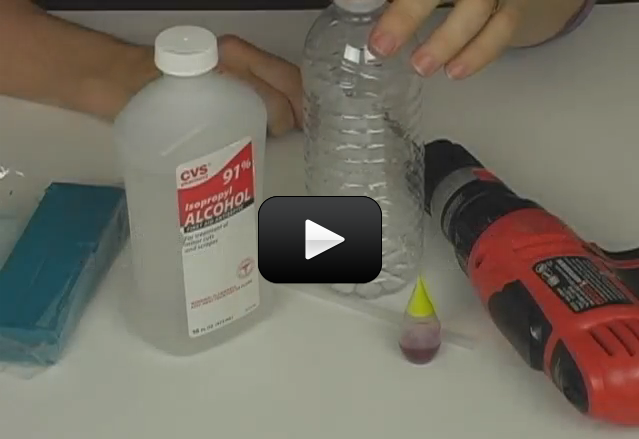First invented in the 1600s, thermometers measure temperature using a sensor (the bulb tip) and a scale. Temperature is a way of talking about, measuring, and comparing the thermal energy of objects. We use three different kinds of scales to measure temperature. Fahrenheit, Celsius, and Kelvin. (The fourth, Rankine, which is the absolute scale for Fahrenheit, is the one you’ll learn about in college.)
Mr. Fahrenheit, way back when (18th century) created a scale using a mercury thermometer to measure temperature. He marked 0° as the temperature ice melts in a tub of salt. (Ice melts at lower temperatures when it sits in salt. This is why we salt our driveways to get rid of ice). To standardize the higher point of his scale, he used the body temperature of his wife, 96°.
As you can tell, this wasn’t the most precise or useful measuring device. I can just imagine Mr. Fahrenheit, “Hmmm, something cold…something cold. I got it! Ice in salt. Good, okay there’s zero, excellent. Now, for something hot. Ummm, my wife! She always feels warm. Perfect, 96°. ” I hope he never tried to make a thermometer when she had a fever.
Just kidding, I’m sure he was very precise and careful, but it does seem kind of weird. Over time, the scale was made more precise and today body temperature is usually around 98.6°F.
Later, (still 18th century) Mr. Celsius came along and created his scale. He decided that he was going to use water as his standard. He chose the temperature that water freezes at as his 0° mark. He chose the temperature that water boils at as his 100° mark. From there, he put in 100 evenly spaced lines and a thermometer was born.
Last but not least Mr. Kelvin came along and wanted to create another scale. He said, I want my zero to be ZERO! So he chose absolute zero to be the zero on his scale.
Absolute zero is the theoretical temperature where molecules and atoms stop moving. They do not vibrate, jiggle or anything at absolute zero. In Celsius, absolute zero is -273 ° C. In Fahrenheit, absolute zero is -459°F (or 0°R). It doesn’t get colder than that!
As you can see, creating the temperature scales was really rather arbitrary:
“I think 0° is when water freezes with salt.”
“I think it’s just when water freezes.”
“Oh, yea, well I think it’s when atoms stop!”
Many of our measuring systems started rather arbitrarily and then, due to standardization over time, became the systems we use today. So that’s how temperature is measured, but what is temperature measuring?
Temperature is measuring thermal energy which is how fast the molecules in something are vibrating and moving. The higher the temperature something has, the faster the molecules are moving. Water at 34°F has molecules moving much more slowly than water at 150°F. Temperature is really a molecular speedometer.
Let’s make a quick thermometer so you can see how a thermometer actually works:
Please login or register to read the rest of this content.


Try changing the temperature dramatically, like starting with it in the fridge to be your coldest temperature (leave it there overnight), and then place it in full sun the next morning. Do you notice a change in the level at all?
We are having the same issue as Lesley, using the same size bottle and length of straw. Ours, in fact is not rising above the lid, and we have the bottle filled to capacity with the solution. the temperature outside is 60 deg F.
There’s two different Apologia curriculum to choose from:
https://www.sciencelearningspace2.com/grade-levels/advanced-projects-2/apologia-chemistry/
https://www.sciencelearningspace2.com/grade-levels/advanced-projects-2/apologia-ap-chemistry/
You’ll find them by clicking on Grade Level –> Advanced:
https://www.sciencelearningspace2.com/grade-levels/advanced-projects-2/
or by tying “Apologia Chemistry” into the search bar. Hope this helps!
We are not finding the experiments from Apologia on your website. Your website indicates that there is an experiment for 2.1 and 2.2 however when we try to pull it up we just find reading. Is this a mistake? Where are the experiments that correlate with Apologia Chemistry?
Yes that’s right! Atoms jiggle around more the higher the temperature. Look at the intro video to this section for more details on how this works.
How does this work? Do the atoms need more room when the temperature changes?
Thank you
Zachary
Hi Aurora! The bottle is 32 oz. We filled it half way with rubbing alcohol and the other half with cold tap water to the rim. The straw decends into the bottle about about 3.5 inches, and is a total of 5.5 inches long. We used three drops of blue food coloring.
Hi Lesley! Can you tell me more about your experiment? How big is the bottle, how full did you make it, what temperature difference did you really experience (using a calibrated thermometer)?
Our solution did not rise up our straw very far, in fact it was barely above the hot glue line. Could it be that the depth of the straw in the bottle was not great enough? What else could have been the cause?
Yes ethanol should work fine. you can always just try it if you aren’t sure and see what kind of results you get (just like a real scientist!)
Can we use Ethyol Alcohol? Is that the same as Rubbing Alcohol? Just curious because I have one but not the other and was wondering if I need to go to the store to get the other?
Thanks for your eagle eye! We’ll get that updated. Sorry about that!
Rubbing Alcohol is not on the Materials Needed list 🙂
Yes, alcohol evaporates quickly, so this is a great for a quick demo.
We set this up, but within a day or two we start losing solution (I guess it’s evaporating?) — is it only supposed to work for a short amount of time?